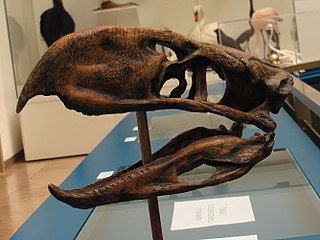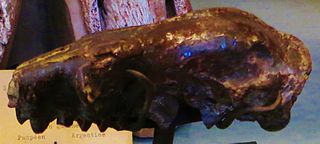
Phorusrhacos is an extinct genus of giant flightless terror birds that inhabited South America during the Miocene epoch. Phorusrhacos was one of the dominant land predators in South America at the time it existed. It is thought to have lived in woodlands and grasslands.

Borhyaena is an extinct genus of South American metatherian, living between 17.5 and 15.5 million years ago in Patagonia, Argentina and Chile.

Theosodon is an extinct genus of litoptern mammal from the Early to Middle Miocene of South America.

Palaeospheniscus is an extinct genus of penguins belonging to the subfamily Palaeospheniscinae. These penguins are apparently not closely related to the modern genus Spheniscus.

Cramauchenia is an extinct genus of litoptern South American ungulate. Cramauchenia was named by Florentino Ameghino. The name has no literal translation. Instead, it is an anagram of the name of a related genus Macrauchenia. This genus was initially discovered in the Sarmiento Formation in the Chubut Province, in Argentina, and later it was found in the Chichinales Formation in the Río Negro Province and the Cerro Bandera Formation in Neuquén, also in Argentina, in sediments assigned to the SALMA Colhuehuapian, as well as the Agua de la Piedra Formation in Mendoza, in sediments dated to the Deseadan. In 1981 Soria made C. insolita a junior synonym of C. normalis. A specimen of C. normalis was described in 2010 from Cabeza Blanca in the Sarmiento Formation, in sediments assigned to the Deseadan SALMA.
Imagocnus is an extinct genus of ground sloth from the Early Miocene (Burdigalian) Lagunitas Formation of Cuba.

Hesperotestudo is an extinct genus of tortoise native to North and Central America from the Early Miocene to the Late Pleistocene. Species of Hesperotestudo varied widely in size, with a large undescribed specimen from the Late Pleistocene of El Salvador reaching 150 cm (4.9 ft) in carapace length, larger than that of extant giant tortoises. Historically considered a subgenus of Geochelone, it is now considered to be distantly related to that genus. Its relationships with other tortoises are uncertain. The exposed areas of the bodies of Hesperotestudo species were extensively covered with large dermal ossicles, which in life were covered in keratin. It has been suggested that species of Hesperotestudo were relatively tolerant of cold weather. Hesperotestudo became extinct at the end of the Pleistocene roughly co-incident with the arrival of the first humans in North America. There is apparently a site in Florida where one individual may have been killed that some suggested were evidence of butchering, although others suggested that the turtle was neither cooked nor does a ledge that was found near it date at the same time as it.
The South American land mammal ages (SALMA) establish a geologic timescale for prehistoric South American fauna beginning 64.5 Ma during the Paleocene and continuing through to the Late Pleistocene. These periods are referred to as ages, stages, or intervals and were established using geographic place names where fossil materials where obtained.

Gryposuchus is an extinct genus of gavialid crocodilian. Fossils have been found from Argentina, Colombia, Venezuela, Brazil and the Peruvian Amazon. The genus existed during the Miocene epoch. One recently described species, G. croizati, grew to an estimated length of 10 metres (33 ft). Gryposuchus is the type genus of the subfamily Gryposuchinae, although a 2018 study indicates that Gryposuchinae and Gryposuchus might be paraphyletic and rather an evolutionary grade towards the gharial.

The Hawthorn Group is a stratigraphic unit of Miocene age in South Carolina, Georgia, and Florida, in the United States. It is known for its phosphate rock resources, and for its rich assemblages of Neogene vertebrate fossils.
Gryposuchinae is an extinct subfamily of gavialid crocodylians. Gryposuchines lived mainly in the Miocene of South America. However, "Ikanogavialis" papuensis may have survived more recently, into the Late Pleistocene/Holocene. Most were long-snouted coastal forms. The group was named in 2007 and includes genera such as Gryposuchus and Aktiogavialis, although a 2018 study indicates that the group might be paraphyletic and rather an evolutionary grade towards the gharial.

Xenastrapotherium is an extinct genus of astrapothere, a type of hoofed herbivorous mammal, native to South America, which lived in the Middle to Late Miocene period, typically during the Laventan stage. It is a member of the family Astrapotheriidae in the subfamily Uruguaytheriinae, large astrapotheres, equipped with a trunk-like nose and protruding teeth, similar to the elephants, but their tusks were the canine teeth, not the incisors. Xenastrapotherium was a genus widely distributed in northern South America, in contrast to other species of astrapotheres which lived in the area of the Southern Cone of the continent. It differed from other astrapotheres by having two lower incisors on each side of the jaw and the tusks have a pronounced longitudinal curvature, although their general shape and size are probably very similar to Astrapotherium, whose weight would be 900 to 1,500 kilograms, comparable to the current black rhinoceros.

Thylacosmilidae is an extinct family of metatherian predators, related to the modern marsupials, which lived in South America between the Miocene and Pliocene epochs. Like other South American mammalian predators that lived prior to the Great American Biotic Interchange, these animals belonged to the order Sparassodonta, which occupied the ecological niche of many eutherian mammals of the order Carnivora from other continents. The family's most notable feature are the elongated, laterally flattened fangs, which is a remarkable evolutionary convergence with other saber-toothed mammals like Barbourofelis and Smilodon.

Nematherium is an extinct genus of ground sloth belonging to Mylodontoidea, it is either considered to be a member of Mylodontidae or Scelidotheriidae. It lived during the Middle Miocene epoch (Santacrucian). Fossils have been found in the Cura-Mallín Formation of Chile and the Santa Cruz and Sarmiento Formations of Argentina.

Pelecyodon is an extinct genus of ground sloths from the Early Miocene (Santacrucian) of South America. Fossils have been found in the Santa Cruz Formation in Argentina.
Santo Domingo Formation is a mainly marine Miocene sedimentary formation located in south–central Chile. The formation was defined by R. Martínez Pardo and Mario Pino in 1979 and named after the roadcut locality they studied about 19 kilometres (12 mi) southeast of Valdivia. Sediments of the formation accumulated in Valdivia and Osorno–Llanquihue Basin.

Eionaletherium is an extinct genus of ground sloth from the Late Miocene coasts of Venezuela containing one species: E. tanycnemius.
Scaphokogia is an extinct genus of pygmy sperm whales that lived off the coasts of Mexico and Peru, South America during the Late Miocene to Late Pliocene. Two species have currently been described: the type species S. cochlearis and S. totajpe. Fossils of Scaphokogia have been found in the Tirabuzon Formation of Baja California and the Pisco Formation of Peru. Scaphokogia existed about 5 million years ago, and were relatively rare animals.
The Cocinetas Basin is a small sedimentary basin of approximately 1,000 square kilometres (390 sq mi) in northeasternmost Colombia. The onshore pull-apart basin is located in the department of La Guajira at the border with Zulia, Venezuela. The basin is bound by three sets of hills; the Serranía de Jarara, Serranía Macuira and Serranía Cocinas, with the eastern boundary formed by the Gulf of Venezuela, part of the Caribbean Sea.
Pternoconius is an extinct genus of macraucheniid litoptern from the Late Oligocene and Early Miocene of Argentina. Fossils of this genus have been found in the Sarmiento Formation of Argentina.


















